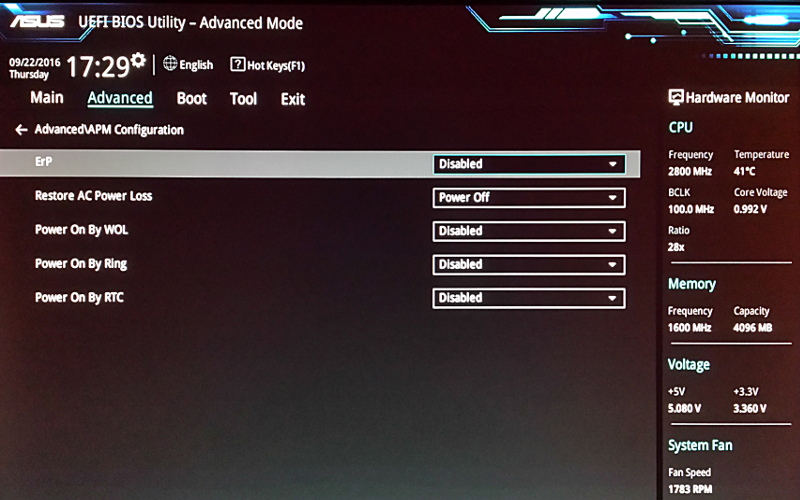Table of Contents
Asus VivoMini VC65
- CPU Intel Pentium G4400T @ 2.90GHz
- Intel High Definition Graphics 510
- Ethernet Realtek RTL8111/8168/8411 PCI Express Gigabit
- WiFi Atheros QCA9565 / AR9565
- Bluetooth USB controller IMC Networks 13d3:3472
Wake-on-LAN
To enable Wake-on-LAN you must enter the BIOS setup (Pressing F2 or Canc at boot). Enter the Advanced, APM Configuration menu and disable the ErP. ErP (Energy-related_products) support determines whether to let the system consume less than 1W of power in S5 (shutdown) state. This feature is not compatible with Power On By WOL and other nice features like Restore AC Power Loss, etc.
Installing Debian Linux
In short, starting from a plain Debian 8 Jessie, we needed the following extra packages:
- linux-image-4.6.0 (from jessie-backports)
- linux-base_4.3 (from jessie-backports)
- firmware-realtek (from jessie-backports)
- firmware-misc-nonfree (from jessie-backports)
- firmware-atheros (from Debian Stretch)
- xserver-xorg-video-intel (from jessie-backports or pinning from Debian Stretch)
- libgl1-mesa-dri (from jessie-backports)
Firmwares
This is the list of non-free firmwares needed by the hardware:
- skl_dmc_ver1.bin (provided by
firmware-misc-nonfree), required for graphics card power management. - rtl8168h-2.fw (provided by
firmware-realtek), required by the Ethernet controller. - AthrBT_0x31010100.dfu (provided by
firmware-atheros), this is the Bluetooth firmware.
Intel HD Graphics 510, X.org and 3D acceleration
We installed Debian 8 Jessie, but found that kernel linux-image-3.16.0 does not handle the Intel High Definition Graphics 510 GPU. At boot time no Intel framebuffer is detected and text console is just 80×25 chars. So we installed linux-image-4.6.0 from jessie-backports, now the kernel detects the GPU and text console is now at high resolution:
[drm] Initialized i915 1.6.0 20160229 for 0000:00:02.0 on minor 0 i915 0000:00:02.0: fb0: inteldrmfb frame buffer device
X.org does not recognize the Intel card and uses a generic Vesa driver; forcing the /etc/X11/xorg.conf file in this way:
Section "Device"
Identifier "device1"
Driver "intel"
EndSection
no devices are detected and X server does not start at all. The error in /var/log/Xorg.0.log is:
[ 8879.997] (II) intel: Driver for Intel(R) Integrated Graphics Chipsets:
i810, i810-dc100, i810e, i815, i830M, 845G, 854, 852GM/855GM, 865G,
915G, E7221 (i915), 915GM, 945G, 945GM, 945GME, Pineview GM,
Pineview G, 965G, G35, 965Q, 946GZ, 965GM, 965GME/GLE, G33, Q35, Q33,
GM45, 4 Series, G45/G43, Q45/Q43, G41, B43, HD Graphics,
HD Graphics 2000, HD Graphics 3000, HD Graphics 2500,
HD Graphics 4000, HD Graphics P4000, HD Graphics 4600,
HD Graphics 5000, HD Graphics P4600/P4700, Iris(TM) Graphics 5100,
HD Graphics 4400, HD Graphics 4200, Iris(TM) Pro Graphics 5200
[ 8880.003] (EE) No devices detected.
The problem is with xserver-xorg-video-intel package: Jessie has the old 2.21.15 version. We need instead the newer 2.99.917 version from jessie-backports or pinning it from Debian Stretch (testing).
Finally we needed a newer Mesa library for 3D acceleration. Starting a 3D-aware program with Jessie library will bring the error:
pci id for fd 50: 8086:1902, driver (null) i965_dri.so does not support the 0x1902 PCI ID.
Just download and install the package libgl1-mesa-dri version 11.1.3 form jessie-backports, which will replace the 10.3.2 version.

